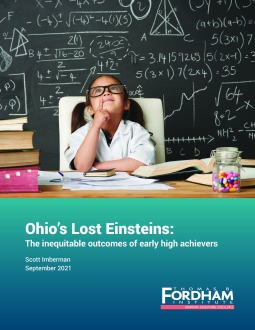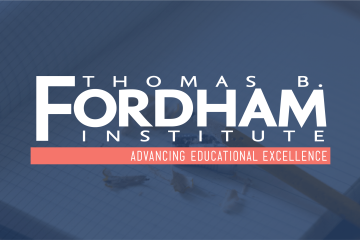Too often, high-achieving students get lost in the shuffle in debates about improving education for all. Yet to keep the U.S. and Ohio competitive on a global scale, we need to nurture a next generation of inventors, scientists, and business leaders. Recent debates about race and equity have shown the importance of ensuring that high-achieving children from all backgrounds have ample opportunity to reach the highest rungs of the social ladder.
To shed more light on high-achieving students, Fordham’s latest research report tracks the educational outcomes of Ohio children who scored in the top 20 percent on their third grade math or English language arts exams. Dr. Scott Imberman of Michigan State University conducted deep-dive analyses that follow early high achievers into college.
Key findings include:
- Gifted identification: Just 34 percent of economically disadvantaged early high achievers and 30 percent of Black early high achievers were formally identified by their schools as gifted. Among other early high achievers, just over half were identified in that way.
- ACT exams: Less than half of economically disadvantaged and Black early high achievers took the ACT—47 and 41 percent, respectively. This compares with 71 percent of non-disadvantaged high achievers who participated in the predominant college entrance exam used in Ohio. (During the period of this study, the ACT was voluntary for Ohio students.)
- AP exams: Economically disadvantaged and Black early high achievers took an average of 0.3 and 0.2 AP exams, respectively, versus 0.7 exams for non-disadvantaged high achievers. Average AP exam scores were also lower for those student groups relative to their peers.
- Four-year college enrollment: Just 35 percent of economically disadvantaged and 26 percent of Black early high achievers went on to enroll in four-year colleges. This compares with 58 percent of non-economically disadvantaged and 57 percent of White high achievers who enrolled in such institutions.
In addition to documenting these disparities in outcomes among high achievers of different backgrounds, Dr. Imberman also examined the impact of being identified as gifted on early high achievers’ later state test scores. Based on rigorous statistical analyses, he finds that gifted identification modestly improves math achievement for Black early high achievers.
Download the report to dive into the analyses, and consider some ideas that could help ensure that all high-achievers reach their potential.
*****


*****



